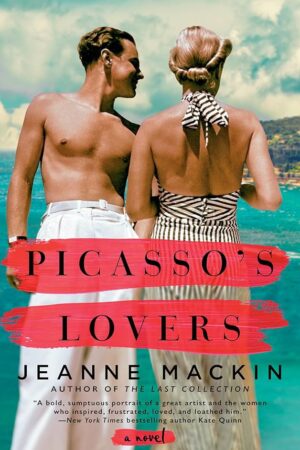Picasso’s Lovers
by Jeanne Mackin
reviewed by Gabrielle Stecher
From Jeanne Mackin, author of The Last Collection: A Novel of Elsa Schiaparelli and Coco Chanel (2019), comes Picasso’s Lovers, her latest historical novel that foregrounds the secret histories of the Spanish artist’s muses. This is a novel, first, that reminds us of Picasso’s godlike ability to render his subjects. The ethereal quality of his artistry provokes one character to describe one of the artist’s floral paintings as a “kind of manifestation of divinity, if you will. The eternal.” But Picasso’s Lovers is far from an uncritical celebration of the artist. Mackin helps us figure out how to enjoy revolutionary art without endorsing its creator’s destructive behavior, showing what a more complicated relationship to artistic genius might look like.
The novel centers on an aspiring arts writer named Alana Olsen. Alana’s mother, an enigmatic scarf designer with a past largely unknown to her daughter, has recently passed away following a cancer diagnosis, and Alana must confront her grief while charting her next steps professionally and personally. In her final days, Alana’s mother encourages her daughter to embrace the financial and social security of marriage to her lawyer fiancé William. But Alana is apprehensive about trading her passion for art history and left-wing activism for a future of childrearing and secretarial work at her husband’s firm.
Writing about Pablo Picasso, her mother’s favorite artist, becomes a way for Alana to stay connected to her mother while forging a professional path as an arts writer in 1953. Alana believes she has what it takes to break into a male-dominated industry—if only her editor will give her the chance. Along the way, family history collides with the present as she investigates Picasso, his circle, and the summer of 1923 when he painted his neoclassical composition The Lovers.
Through its dual timelines, Picasso’s Lovers reveals what it was like to be a female arts writer and artist in the middle of the twentieth century. In establishing her career, Alana desperately wishes to play a role in bringing the work of women artists to the public. At the same time, she dismisses the notion that being an artist’s model meant intrinsically giving into objectification and sexual submission at the expense of one’s own creative and professional ambition. The novel unpacks the tensions that arise when one oscillates between the status of artist and art object, of lover and disappointed ex-flame replaced by a newer model. On the one hand, there is the perspective of Sara Murphy, a wealthy expatriate and patron of the Lost Generation who Alana interviews. She describes the experience of being painted by Picasso as a second sexual awakening: “There is nothing more sensual than being studied, having the lines of your body, the texture of your skin, translate into an object that is both you and not you. A work of art.” On the other hand, Picasso’s Lovers acknowledges and laments the violence women experience when they are bedded and swiftly disposed of by serial seducers like Picasso, who was emboldened by fame and his widely touted (not to mention self-asserted) genius status.
Detracting from the power of the novel’s commentary on the woman as art(ist) dichotomy, however, is the predictability of its plot. In its interrogation of the personal, professional, and political resistance required of women devoted to their creative labor, as well as in its narrative trajectory, Picasso’s Lovers too closely mimics the structure of Taylor Jenkins Reid’s The Seven Husbands of Evelyn Hugo (Atria Books, 2017). In Mackin’s novel, as in Reid’s, a young female writer faces an uncertain future as she grapples with losing a parent while confronting the demise of a romantic partnership that she knows will never be enough. Further, both protagonists experience similar professional pressures as they attempt to prove themselves in the eyes of complicated editors. An even more apparent parallel arises as they both interview an older female subject whose secrets begin to emerge and intersect with the writer’s own. (In Alana’s case, this is Sara Murphy; in the case of Reid’s journalist heroine Monique Grant, it’s a reclusive movie star of a bygone era.) For readers of The Seven Husbands of Evelyn Hugo especially, it is unlikely that any of Mackin’s plot twists will be genuinely surprising.
The truth about Alana’s mother’s identity may come as no surprise, but feminist art critics and readers can still find much to admire in Mackin’s novel. Picasso’s Lovers is a hopeful and inspiring read that, through its reconsideration of the women in Picasso’s life, tasks all readers to engage with the artist’s work with a fresh eye—and a more discerning one—during their next encounter.
Published on January 6, 2025

